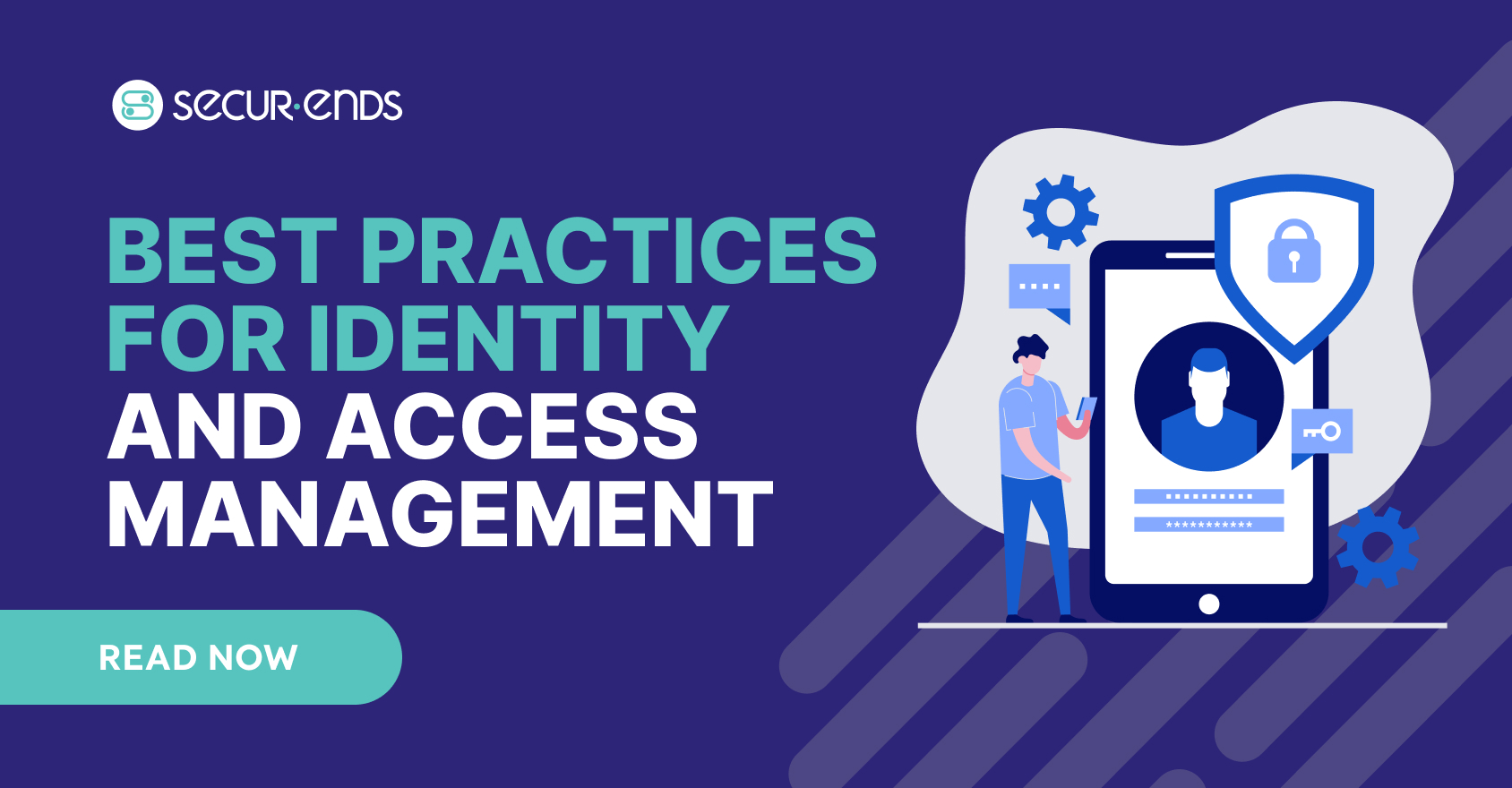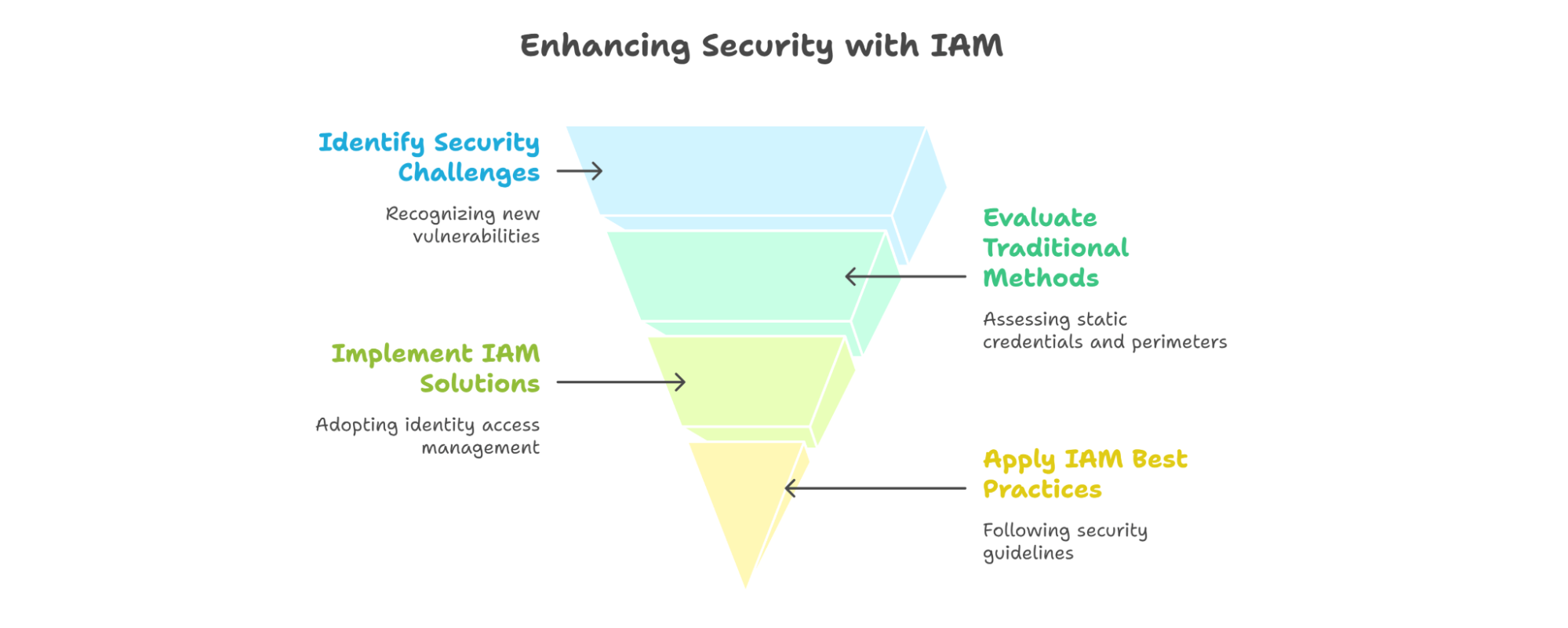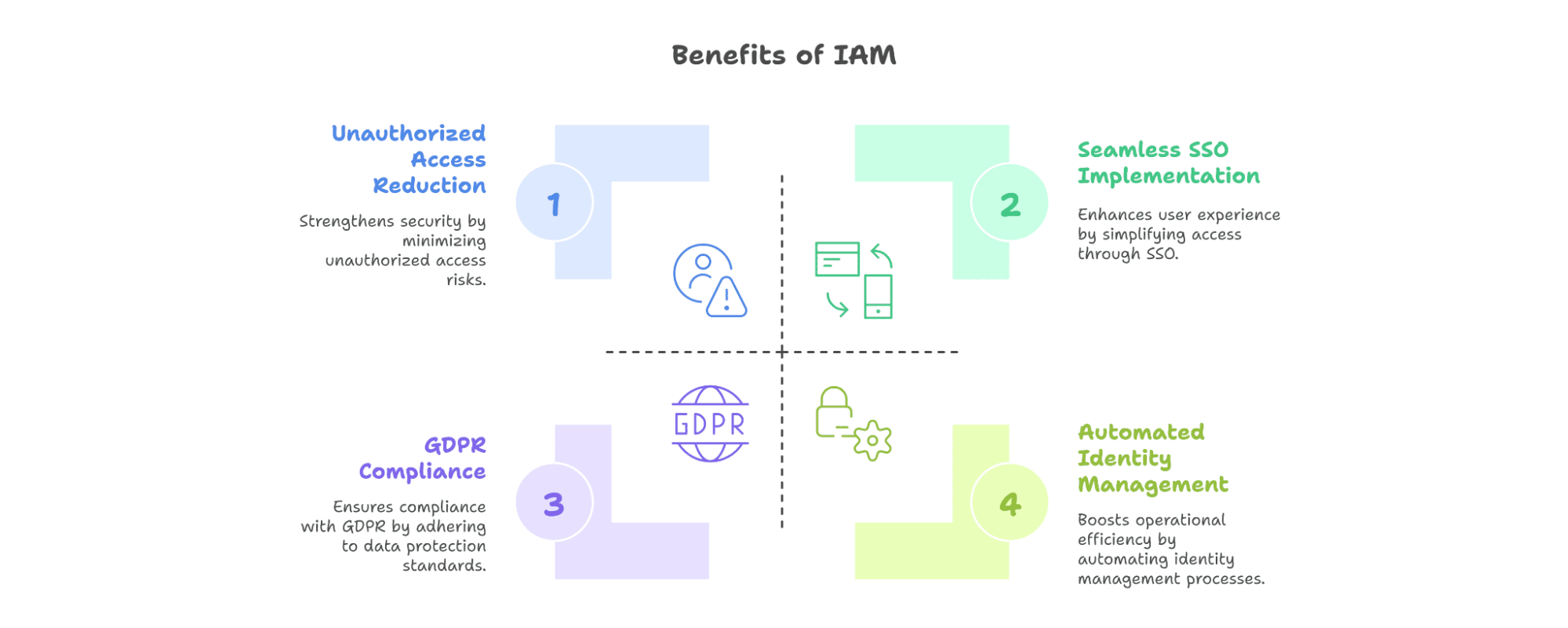Best Practices for Identity and Access Management
Best Practices for Identity and Access Management

Introduction
The rapid adoption of cloud computing has revolutionized how businesses store, access, and manage data. However, this shift has also introduced new security challenges, making traditional access control methods insufficient in protecting sensitive information. Static credentials and perimeter-based security models no longer provide the level of protection required in today’s dynamic IT environment.
Identity Access Management (IAM) solutions offer a structured approach to managing user identities, authentication, and access privileges across an organization’s digital ecosystem. By implementing IAM best practices, businesses can strengthen their security posture, ensure compliance with regulatory standards, and enhance operational efficiency. Proper IAM implementation not only minimizes unauthorized access but also provides a seamless user experience while maintaining robust IGA security controls.

Understanding Identity Access Management (IAM)
Identity Access Management (IAM) is a framework of policies, technologies, and processes that govern user access to digital resources. It ensures that only authorized individuals and systems can access specific applications, data, and networks while maintaining security, compliance, and operational efficiency.
Key Components
- Authentication & Authorization
- Authentication verifies a user’s identity before granting access. This can be achieved through passwords, biometrics, multi-factor authentication (MFA), and single sign-on (SSO).
- Authorization determines what actions an authenticated user can perform within a system, following role-based access control (RBAC) or attribute-based access control (ABAC).
- Identity Governance and Administration (IGA)
- Identity Governance and Administration (IGA) ensures compliance with IGA security policies and regulatory requirements by managing user identities, user access reviews, and automated provisioning/deprovisioning.
- It enables centralized visibility and enforcement of access policies across an organization.
- Federated Identity Management
- Federated Identity Management (FIM) allows users to access multiple systems across different organizations with a single set of credentials.
- It relies on standards like Security Assertion Markup Language (SAML) and OpenID Connect to enable seamless authentication across platforms.
- Customer Identity & Access Management (CIAM)
- Customer Identity & Access Management (CIAM) focuses on managing external user identities, such as customers, ensuring secure and frictionless access to digital services.
- It integrates authentication, self-service registration, and consent management to enhance user experience and regulatory compliance.
Importance of IAM
IAM plays a crucial role in securing enterprise resources by ensuring that the right individuals have the right access at the right time. Its significance includes:
- Enhancing Security: Reducing the risk of unauthorized access and data breaches.
- Regulatory Compliance: Ensuring adherence to industry standards such as GDPR, HIPAA, and PCI-DSS.
- Operational Efficiency: Automating identity lifecycle management to streamline access control.
- Improved User Experience: Enabling seamless authentication through SSO and adaptive access controls.

Challenges in IAM Implementation
- IAM Risk Management
- Managing privileged access and preventing credential-based attacks.
- Ensuring proper identity verification and access logging.
- Compliance Requirements
- Meeting evolving regulatory mandates for data protection and user access control.
- Keeping up with audit trails and identity governance standards.
- Evolving Cyber Threats
- Addressing phishing attacks, identity theft, and insider threats.
- Implementing AI-driven security measures to detect and respond to anomalies in real time.
IAM is a foundational element of modern cybersecurity strategies, providing organizations with a structured approach to managing access while mitigating security risks by IAM Risk Management .
Top IAM Best Practices
Identity and Access Management (IAM) is a critical component of modern cybersecurity strategies, ensuring that only authorized individuals and systems gain access to sensitive resources. With evolving cyber threats and stringent compliance regulations, organizations must implement robust IAM best practices to strengthen security and streamline access management. Below are the top IAM best practices businesses should follow to safeguard their digital assets effectively.
1. IAM Policies and Access Controls
Establishing clear IAM policies is the foundation of a strong security framework. Organizations should begin by identifying security gaps and defining IAM objectives that align with business needs and compliance mandates like GDPR, HIPAA, and PCI-DSS. Access control policies should be structured based on the principle of least privilege, ensuring that users have only the necessary permissions required for their roles.
Additionally, investing in Identity and Access Management Certifications for employees enhances expertise, ensuring that IAM strategies are implemented and managed efficiently.
2. Adopt Multi-Factor Authentication (MFA)
Multi-Factor Authentication (MFA) is one of the most effective ways to mitigate unauthorized access risks. By requiring multiple authentication factors, such as passwords, biometrics, or one-time security codes, organizations can significantly reduce the chances of credential-based attacks. Implementing MFA across all access points helps protect user identities and adds an extra layer of security, particularly for high-privilege accounts.
3. Implement Role-Based Access Control (RBAC) and Attribute-Based Access Control (ABAC)
Access control should be structured based on user roles (RBAC) or attributes (ABAC) to limit excessive privileges and reduce security risks. Role-Based Access Control (RBAC) assigns access based on job functions, ensuring that users receive permissions relevant to their responsibilities. Meanwhile, Attribute-Based Access Control (ABAC) considers attributes like location, device type, and time of access, making it a more dynamic approach to access control.
Organizations should also implement micro-segmentation, which limits access to specific network segments, and Just-In-Time (JIT) access to grant temporary permissions only when needed, minimizing the risk of unauthorized activities.
4. Enforce Just-In-Time (JIT) Access
Just-In-Time (JIT) access ensures that privileged access is granted only for a specific duration, reducing exposure to potential cyber threats. By verifying every access request and implementing real-time security monitoring, organizations can prevent unauthorized users from gaining persistent access to sensitive systems. This approach aligns with the zero-trust security model, which assumes that no user or device should be trusted by default.
5. Leverage Passwordless Authentication Methods
Traditional passwords pose significant security risks, from phishing attacks to credential leaks. Passwordless authentication methods, such as biometrics, device-based authentication, and security tokens, offer a more secure and user-friendly alternative. By adopting passwordless authentication, organizations can enhance security while reducing the risk of compromised credentials.
6. Automate IAM Workflows
Automating IAM processes enhances efficiency and minimizes human errors. Organizations should leverage automated Identity Governance and Administration (IGA) solutions to streamline user provisioning, monitor inactive accounts, and ensure timely de-provisioning of users when they leave the company. Regular compliance audits using IAM analytics help identify anomalies, ensuring that IGA security policies remain up to date.
7. Enable Secure Federated Identity Management
Federated Identity Management (FIM) allows users to access multiple applications with a single set of credentials, improving both security and user experience. Implementing Single Sign-On (SSO) ensures seamless authentication while maintaining security across cloud and on-premises environments. Organizations should ensure that their identity federation solutions are compatible with various applications and cloud providers to facilitate secure cross-organizational access.
8. Build Compliance-Driven IAM Policies
Compliance with industry regulations is essential for maintaining trust and avoiding penalties. IAM policies should align with security standards like SOC 2, ISO 27001, and PCI-DSS. Implementing Customer Identity and Access Management (CIAM) solutions ensures proper data governance and regulatory adherence. Regular risk assessments and audits help organizations identify vulnerabilities and continuously improve their IAM strategies.
Implementing these IAM best practices can significantly enhance an organization’s security posture, reduce identity-related risks, and ensure regulatory compliance. As cyber threats continue to evolve, businesses must remain proactive in refining their IAM strategies through automation, continuous monitoring, and policy enhancements. By adopting a comprehensive IAM approach, organizations can ensure secure access management while maintaining operational efficiency and user convenience.
Common IAM Challenges & How to Overcome Them
While implementing IAM best practices strengthens security and streamlines user access, organizations often face significant challenges during adoption. Addressing these hurdles proactively ensures more effective and scalable IAM frameworks.
1. Management Buy-in
One of the biggest challenges in IAM implementation is securing executive support. Without leadership backing, IAM initiatives may struggle to receive adequate funding or prioritization.
Solution:
- Build a compelling business case showcasing IAM’s role in risk mitigation, regulatory compliance, and operational efficiency.
- Use real-world case studies to demonstrate the cost of security breaches resulting from weak identity management.
- Highlight how IAM solutions contribute to business agility and digital transformation.
2. Stakeholder Alignment
IAM isn’t just an IT concern—it involves HR, security, compliance, and business teams. Misalignment between these stakeholders can lead to inconsistent policies and operational inefficiencies.
Solution:
- Establish a cross-functional IAM governance team, including representatives from IT, HR, compliance, and security.
- Ensure IAM policies align with workforce needs while maintaining security and regulatory compliance.
- Provide ongoing training and awareness programs to keep all departments informed about IAM protocols.
3. Scalability
As businesses grow, IAM systems must adapt to an increasing number of users, applications, and access points. Many organizations struggle with IAM solutions that become inefficient as they scale.
Solution:
- Invest in cloud-based IAM solutions that offer scalability and flexibility.
- Use automation to manage onboarding, offboarding, and access provisioning efficiently.
- Regularly review IAM policies to accommodate organizational growth and evolving cybersecurity threats.
4. Integration Issues
Many businesses operate in hybrid environments with a mix of legacy systems and modern cloud applications. Ensuring seamless integration between IAM tools and existing infrastructure can be complex.
Solution:
- Choose IAM solutions that support open standards like SAML, OAuth, and OpenID Connect for easier integration.
- Implement API-based IAM systems to facilitate interoperability with third-party applications.
- Work with IAM vendors that offer customization and compatibility with diverse IT environments.
By addressing these common IAM challenges, organizations can build a robust and future-ready identity and access management strategy. Up next, let’s explore the evolving landscape of IAM and future trends shaping identity security.
Conclusion
Identity and Access Management (IAM) plays a crucial role in securing digital assets, preventing unauthorized access, and ensuring regulatory compliance. As cyber threats become more sophisticated, businesses must adopt a proactive approach to IAM, implementing best practices that strengthen security while optimizing user experience.
By defining clear IAM policies, enforcing multi-factor authentication (MFA), leveraging automation, and integrating IAM across hybrid environments, organizations can build a resilient security framework. Additionally, aligning IAM strategies with compliance mandates and industry standards ensures long-term risk mitigation.
Looking ahead, the future of IAM will be driven by AI-powered automation, Zero Trust security models, and seamless cloud integrations. A key enabler of efficient IAM implementation is the System for Cross-domain Identity Management (SCIM) API, which simplifies user provisioning and de-provisioning across multiple applications. By leveraging SCIM API, organizations can automate identity lifecycle management, reduce administrative overhead, and ensure consistent access control policies across diverse platforms.
As IAM continues to evolve, staying ahead of emerging threats and adopting innovative solutions like SCIM API will be key to maintaining a secure, scalable, and seamlessly integrated identity management ecosystem.